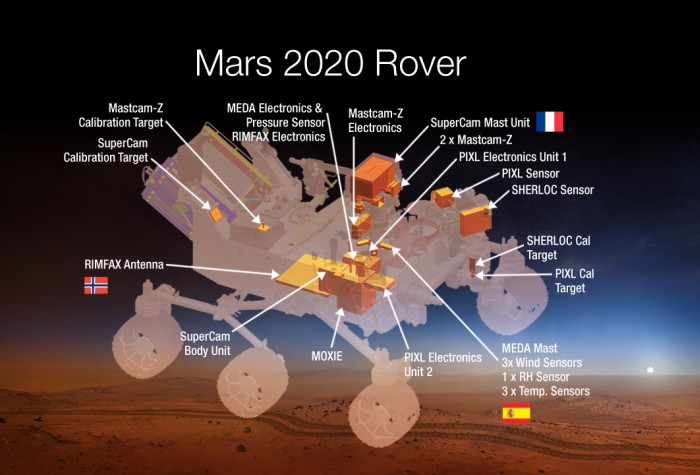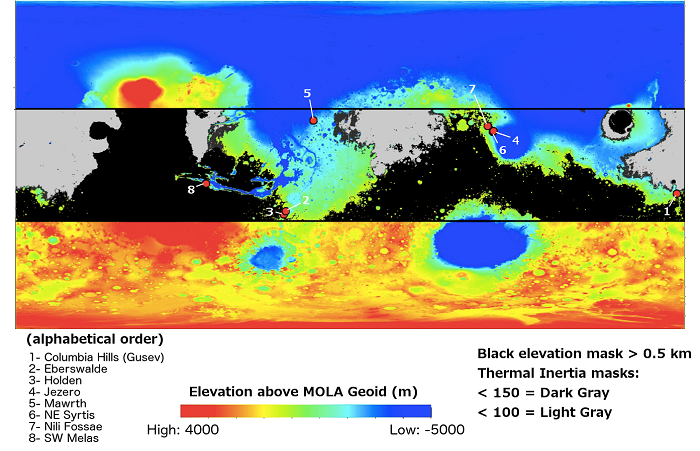Experts choose the landing site of the next rover

In August this year, more than 150 scientists who are interested in the exploration of Mars gathered for a conference in the city of Monrovia (California). The task was to evaluate and discuss the prospects of two dozen potential landing sites for the planet rover within the framework of the Mars 2020 mission .
The new Mars 2020 rover is in many ways similar to the Curiosity rover launched to Mars during the mission of the Martian science lab. In contrast, Mars 2020 will not only have to drill the surface of the Red Planet in several places, obtain soil samples, deliver them to Earth for further analysis.
To select suitable landing sites from many candidates, the same scientific process was used as in previous missions, involving many narrow specialists from different fields and public discussion, said Ken Farley , professor of geochemistry at California University of Technology, lead scientist at the Mars project -2020. "
Then there was a vote for each candidate. Five criteria were indicated on the voting card. It was necessary to evaluate how the candidate meets each of these criteria. The voices were summed up and a general score was derived.
When developing the criterion, four tasks were taken into account, which were set as part of the Mars 2020 mission: 1) preparation for the landing of a person, including checking the apparatus that receives oxygen from carbon dioxide in the atmosphere; 2) geological survey of the landing site; 3) search for suitable stones and study them for signs of ancient life; 4) the preparation of approximately 37 samples for shipment to Earth. Just 37 samples the size of a pencil - the maximum amount that can fit in a container of the proposed design. The Mars rover will have to travel a lot, so that 37 samples differ from each other.
Based on the results of the vote, experts selected eight of the most promising out of 21 proposed landing sites.
1. Columbia Hills / Gusev Crater (Columbia Hills / Gusev) - a leading candidate on the list. The Spirit rover studied this area and found silica deposits and fragments of volcanic rock that look exactly like rocks in a geothermal spring in Chile. There is a very high probability of finding traces of life.
2. Crater Eberswalde (Eberswalde).
3. Crater Holden (Holden).
4. Jezero Crater on the low shield volcano Big Sirte.
5. Valley of Mawrth Vallis.
6. The north-eastern part of the low shield volcano Big Sirte (NE Syrtis).
7. The channel of the Nile (Nili Fossae).
8. The southwestern part of the canyon Melas (SW Melas).
All selected are shown on the map.

The experts also determined that the Terrain Relative Navigation (TRN) navigation system is necessary for the successful completion of the mission in all eight selected territories except the Nile Channel Depression. For two other territories, it is impossible to give an unambiguous answer whether TRN is needed for the guaranteed success of the mission: these are the Colombian hills and Holden Crater.
Half of the selected landing sites are in the deltas of crater lakes. Scientists express confidence that it is there that it is more likely to find rocks with signs of a possible ancient life, because it was here that organic material was to be washed off. The second half is “hydrothermal” springs with hot stones that can heat water, it is there that the strangest creatures live in terrestrial conditions, who do not need oxygen or sunlight, but only the geothermal energy of the planet’s core, says Professor Ken Farley. Apparently, even the most ancient signs of life on Earth are found in geothermal sources. In addition, on Mars, rocks in these places have a greater age: 4 billion years instead of 3.6 billion years in crater lakes. The voices between the deltas and geothermal springs were strictly divided in half.
Further discussion is planned at the next meeting of the working group in January 2017. There, scientists will make the final choice between crater lakes and hydrothermal springs. Adherents of each of the two options should be well prepared and present their arguments.
